Examine suspended program
After the debugger session has started, the Debug tool window appears, and the program runs normally until a breakpoint is hit or you pause the program manually.
After that, the program is suspended, allowing you to examine its current state, control its further execution, and test various scenarios at runtime.
tip
If you accidentally closed the Debug tool window, select View | Tool Windows | Debug from the main menu or press to reopen it.
The state of the program is represented by frames. When the program is suspended, the current frame stack is displayed in the Frames pane located on the Threads & Variables tab.
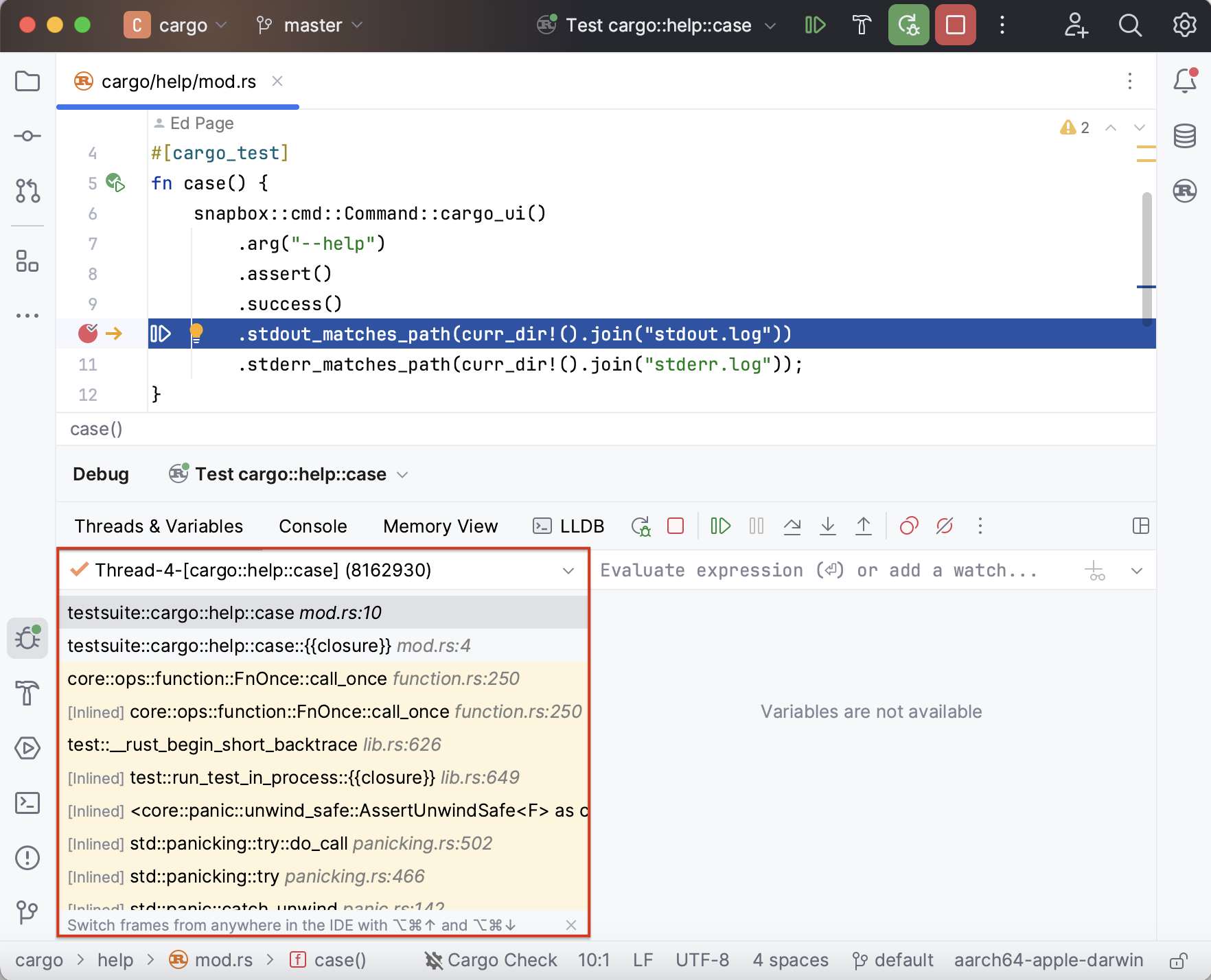
A frame corresponds to an active method or function call. It stores the local variables of the called method or function, its arguments, and the code context that enables expression evaluation.
Each time a method is called, a new frame is added to the top of the stack. When the execution of a method is complete, the corresponding frame is removed from the stack (in the last in, first out fashion).
Examining frames helps you understand why particular parameters were passed to a method and what the state of the caller was at the time of calling.
You can navigate through the list of the application threads. The ID given by the OS on thread start can help you identify the thread you are interested in:
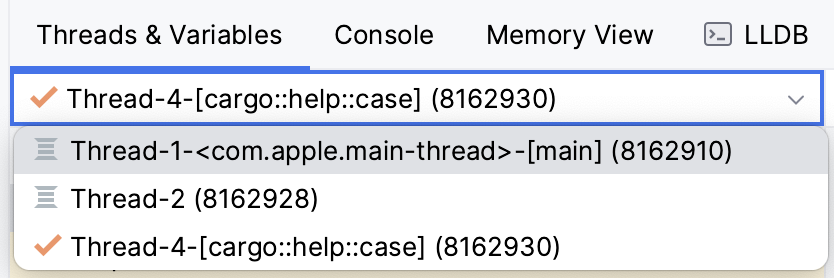
Icons near each thread indicate the status of the thread:
Icon | Description |
|---|---|
The current thread in suspended state. | |
An active thread. | |
The thread that has hit the current breakpoint. | |
A suspended thread. Threads are marked as suspended when they were paused by the debugger. | |
A frozen thread. Threads are marked as frozen when they were manually paused. |
To copy the call stack for the current thread, right-click anywhere on the Frames pane and select Copy Stack.
The Variables pane shows the list of the variables in the selected frame/thread. Examining the variables can help you understand why the program operates in a certain way.
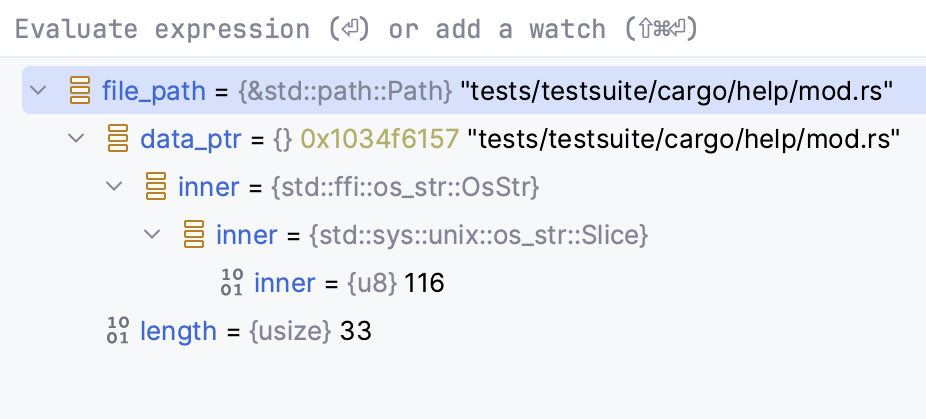
tip
Be mindful of variable scope and lifetime. If a variable is not present on the list, this means the variable is out of scope for the current frame at the current execution point.
To compare a variable value with some other value, use the Compare Value with Clipboard option. This is helpful, for example, when a variable holds a long string, and you need to compare it with another long string.
Copy the content you want to compare, for example, from a text file.
In the Variables pane, right-click a variable and select Compare Value with Clipboard.
Examine the differences in the Diff Viewer that opens.
RustRover allows you to inspect variables in a dedicated dialog. This is useful when you need to keep track of some variable (or the object whose reference it holds) and at the same time be able to navigate between frames and threads.
Right-click a variable or a watch and select Inspect.

If you want to test how the program would behave with certain data or change its flow at runtime, you can achieve that by changing the variable values.
Select a variable and press . Alternatively, select Set Value from the context menu.
Enter the value for the variable and press .

You can navigate to declarations from the Variables pane.
To navigate to the code where the variable is declared, right-click the variable and select Jump to Source .
To navigate to the type declaration of the variable type, right-click the variable and select Jump to Type Source .
RustRover lets you evaluate expressions during a debugging session to obtain additional details about the program state or test various execution scenarios at runtime.
note
When evaluating expressions, be mindful of variable scope and lifetime. All expressions are evaluated in the context of the current execution point.
This feature only works if the program was suspended after hitting a breakpoint (not paused) .
If there are breakpoints inside methods called within the expression, they will be ignored.
To quickly evaluate an expression, point at it in the editor. Note that method calls cannot be evaluated this way.
Point at the expression you want to evaluate. The result of the expression appears in a tooltip.

To view child elements , click .

If you find value tooltips distracting, you can increase the delay or disable them altogether. To do this, in the Settings dialog () , go to Build, Execution, Deployment | Debugger | Data Views and set the Show value tooltip and Value tooltip delay options according to your preference.
If you want to evaluate an expression in the code that involves a method call or indicate a specific portion of the expression to evaluate, use the Quick Evaluate Expression option.
Place the caret at the expression (to evaluate the closest matching expression) or select a portion of it (if you want to be specific about which part of a complex expression to evaluate).
Go to Run | Debugging Actions | Quick Evaluate Expression . Alternatively, hold and click the selection.
tip
When calling methods, make sure you are aware of their possible side effects (for example, changes to an outside variable), as they may alter the program flow or result.
You can configure Quick Evaluate Expression to work for a piece of code on just selecting it (without using the menu/shortcut). Use this option carefully, as you can accidentally call methods when it is enabled.
Go to Settings | Build, Execution, Deployment | Debugger | Data Views and set the Show value tooltip on code selection option.
Evaluating arbitrary expressions is the most flexible evaluating option. It lets you evaluate any custom code as long as it is in the context of the current frame. Using it, you can evaluate declarations, method calls, loops, and so on.
To evaluate an arbitrary expression, enter it in the Evaluate expression field in the Variables pane and press

The result is displayed right below. You can also add the expression to watches by clicking
in the right-hand part of the expression field.

If you want to evaluate long code blocks, you may want to use a dedicated dialog for that:
If you want to start with some expression or a variable, which is currently in front of you (for example, in the editor or on the Variables pane), select it.
Go to Run | Debugging Actions | Evaluate Expression or select Evaluate Expression from the context menu. The shortcut may not work on Ubuntu (for correct operation, adjust the shortcut configuration).
In the Evaluate dialog, modify the selected expression or enter a new one in the Expression field. Click Expand to modify a multiline code fragment.

note
Keep in mind that any variables declared in the body of the expression go out of scope after the expression has been evaluated.
Click Evaluate ( for multiline mode). The expression result appears in the Result field.
The result of the expression is taken from the return statement. When there is no return statement, the result is taken from the last line of code (it does not even have to be an expression: a single literal works too). When there is no valid line to take the value from, the result is
undefined. If the specified expression cannot be evaluated, the Result field indicates the reason.
tip
When calling methods, make sure you are aware of their possible side effects (for example, changes to an outside variable), as they may alter the program flow or result.
The Evaluate dialog is non-modal, so you can switch the focus back to the editor to copy other variables and expressions. You can also open multiple Evaluate dialogs.
RustRover shows the values of the variables right next to their usage.

Once the variable value has changed, the inline view is updated with the new value and changes its color.

If a line contains a reference to an object, you can examine its fields right in the editor. From this popup, you can also change the variable values and add inline watches.
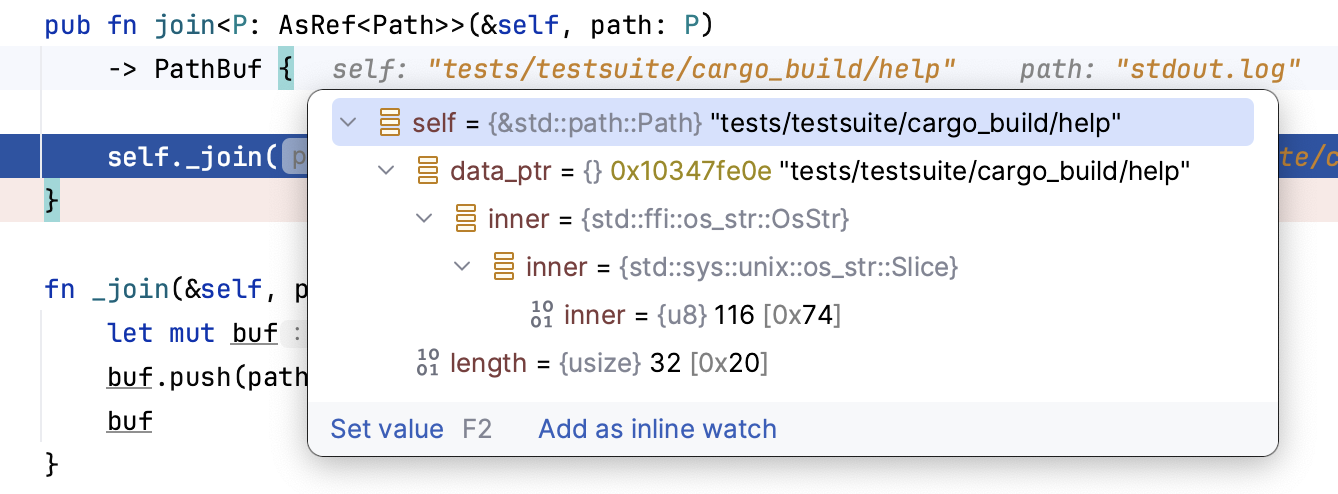
The inline view is enabled by default. To turn it off, in the Settings dialog () , go to Build, Execution, Deployment | Debugger | Data Views and disable the Show values inline option.
If you want the result of some expression to appear on a particular line, you can set up an inline watch for that. Inline watches are persistent and remain active after session restart.
Click the inline hint referring to the object whose field you want to track.
In the popup, select the field and click Add as Inline Watch.

Fine-tune the watch if needed. You can use any valid expression as a watch.
To remove an inline watch, locate it in the Variables pane, right-click, and select Remove Watch:
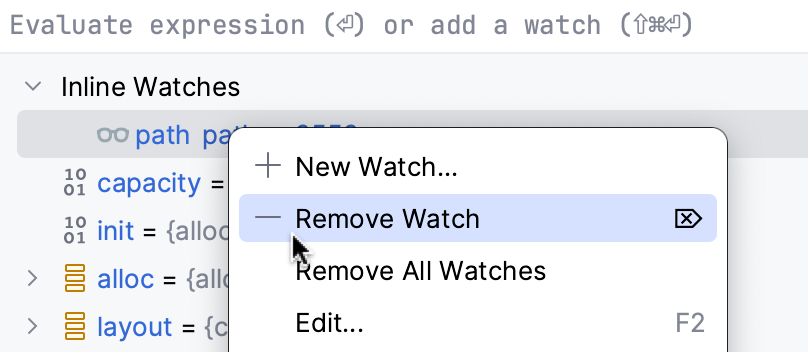
If you want to keep track of some variable or the result of a more complex expression, set up a watch for this variable or expression. This is useful when you need to evaluate something that is not regularly displayed on the list of variables, or to pin some instance variable thus eliminating the need to expand the tree after each step.
This feature only works if the program was suspended after hitting a breakpoint (not paused) .
tip
When calling methods, make sure you are aware of their possible side effects (for example, changes to an outside variable), as they may alter the program flow or result.
Watches are evaluated in the context of the selected frame. Watches cannot be evaluated when they are out of context or when they fail to compile. If this is the case, the watch is marked with the error icon .
By default, watches are shown together with variables in the Variables pane. To hide/reveal the Watches pane, use the Separate watches option in the Layout Settings menu.
Enter the expression in the top part of the Variables pane, then click Add to Watches.

tip
If the variable or expression that you want to track is already in front of you (for example, in the code editor), you can select and drag it to the Variables pane. For variables in the current context, you can also right-click them in the Variables pane and select Add to Watches from the context menu.
After you have added a variable/expression to Watches, it stays there and is evaluated for each step, providing you with the result in the current context.
Right-click the desired watch and select Edit.
Select the watch you want to copy.
Click Duplicate Watch
on the Variables pane or press .
To remove a single watch, right-click it and select Remove Watch. Alternatively, select the watch and press .

To remove all watches, right-click anywhere on the Variables/Watches pane and select Remove All Watches.
Watches allow for the same actions as variables do. For example, you can view them in a dedicated dialog or use them to navigate to the source code.
Watches are a part of your project. This means you can stop and rerun the debugging session without risk of losing them.
Examining the program state involves navigating in code, and you often need to return to the place where your program is suspended.
Do one of the following:
In the main menu, go to Run | Debugging Actions | Show Execution Point.
Press .
Click
on the stepping toolbar of the Debug tool window, then select Show Execution Point
from the list.
The current execution point is indicated with a blue line. The code at this line has not been executed yet.


The Set Execution Point action allows you to jump to an arbitrary line of code in the editor (both forward and backward) during a debug session and set the execution point there, skipping all the other commands in between.
Use one of the following options:
Drag the orange arrow
in the gutter to the required line of code.

Place the caret at the required line and call Set Execution Point to Cursor from Help | Find Action ().

In Settings | Keymap, assign a shortcut for the Set Execution Point to Cursor action.

Save the settings, place the caret at the required line, and use the shortcut.